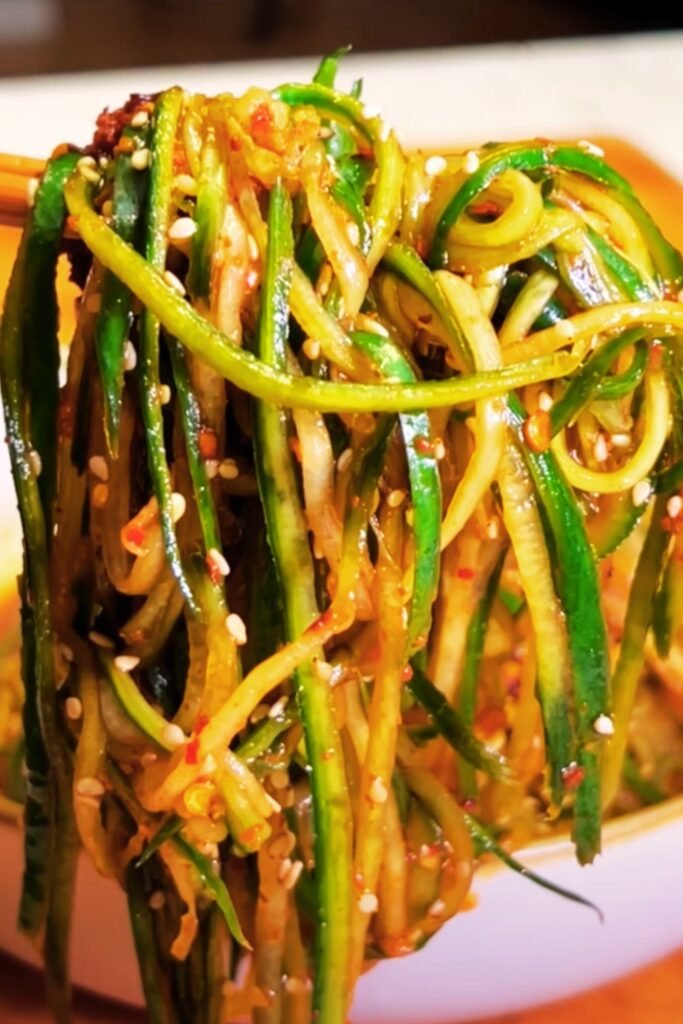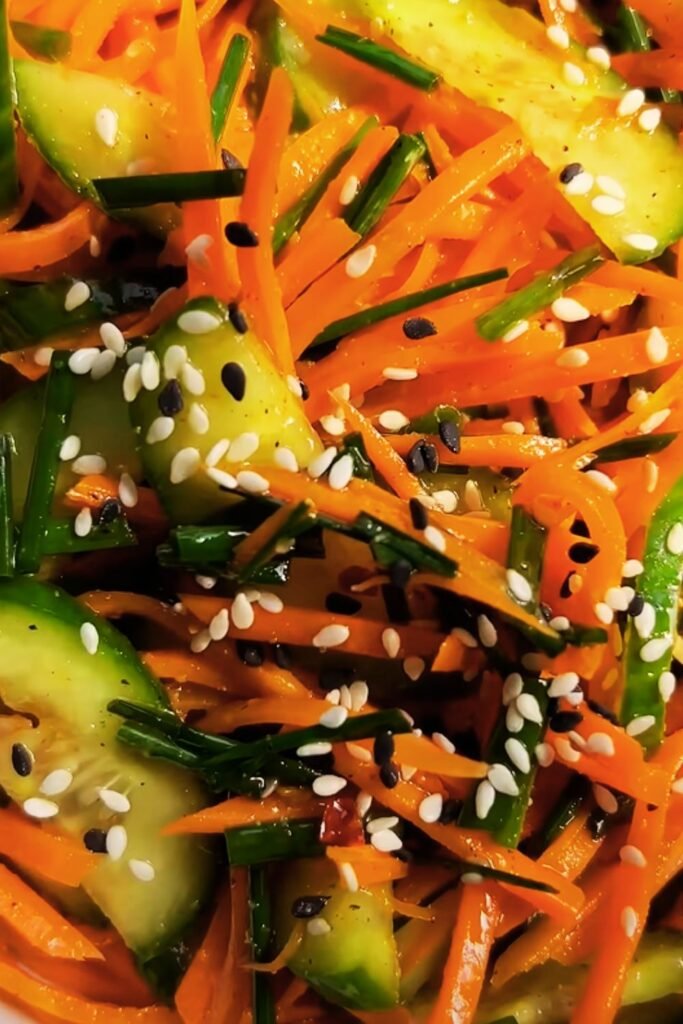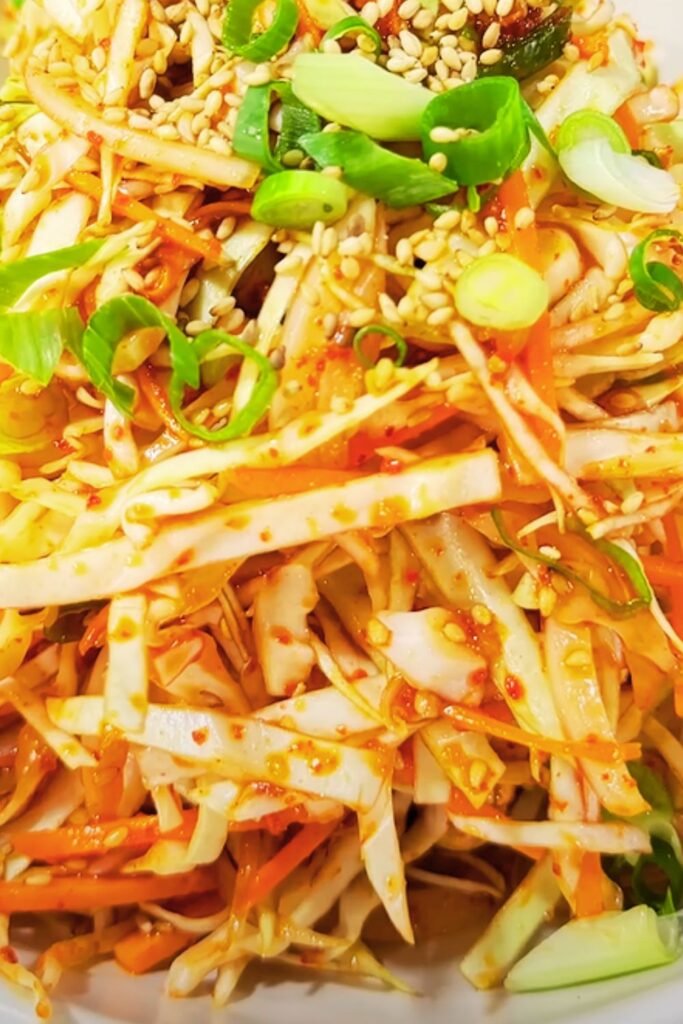When I first discovered the magic of Asian salads, my entire perspective on healthy eating transformed. There’s something absolutely captivating about the way crisp vegetables dance with bold, umami-rich dressings that makes every bite an adventure. Today, I’m sharing my go-to easy Asian salad recipe that has become a staple in my kitchen and consistently impresses my family and friends.
This isn’t just another salad recipe – it’s my gateway to bringing the vibrant flavors of Asian cuisine into my everyday meals. The beauty of this dish lies in its perfect balance of textures, colors, and tastes that come together in harmony. Whether I’m preparing a quick lunch for myself or entertaining guests, this Asian salad never fails to deliver satisfaction and nourishment.
Understanding Asian Salad Fundamentals
Before diving into my recipe, let me share what makes Asian salads truly special. Unlike traditional Western salads that often rely heavily on lettuce as the base, Asian salads embrace a diverse array of vegetables, herbs, and proteins that create complex flavor profiles.
Key Components: : Fresh vegetables providing crunch and nutrition : Aromatic herbs adding fragrance and depth : Protein elements for substance and satisfaction : Bold dressings combining sweet, sour, salty, and umami flavors
Texture Principles: : Contrasting textures from soft to crispy elements : Temperature variations enhancing sensory experience : Color diversity creating visual appeal
The philosophy behind Asian salads centers on achieving perfect balance. Every ingredient serves a purpose, whether it’s adding crunch, providing sweetness, or delivering that essential umami punch that makes your taste buds sing.

My Easy Asian Salad Recipe
After years of experimenting and refining, I’ve developed this foolproof recipe that captures authentic Asian flavors while remaining accessible to home cooks. The preparation takes about 20 minutes, and the results are absolutely worth every second.
Ingredients for the Salad Base
| Ingredient | Quantity | Purpose | Substitution Options |
|---|---|---|---|
| Napa Cabbage | 4 cups, thinly sliced | Provides crispy base texture | Regular cabbage, bok choy |
| Carrots | 2 medium, julienned | Adds sweetness and crunch | Red bell peppers |
| Red Bell Pepper | 1 large, thinly sliced | Color and mild sweetness | Yellow bell pepper |
| Cucumber | 1 large, thinly sliced | Refreshing crunch | English cucumber |
| Snow Peas | 1 cup, trimmed | Crisp texture and color | Sugar snap peas |
| Bean Sprouts | 1 cup, fresh | Delicate crunch | Microgreens |
| Fresh Cilantro | 1/2 cup, chopped | Aromatic freshness | Thai basil |
| Green Onions | 4 stalks, sliced | Mild onion flavor | Chives |
| Sesame Seeds | 2 tablespoons, toasted | Nutty flavor and texture | Crushed peanuts |
Protein Additions (Choose One or Combine)
| Protein | Quantity | Preparation | Flavor Profile |
|---|---|---|---|
| Grilled Chicken | 2 cups, sliced | Marinated and grilled | Savory and substantial |
| Shrimp | 1 pound, cooked | Steamed or grilled | Light and sweet |
| Tofu | 8 oz, cubed | Pan-fried until golden | Neutral and absorbent |
| Edamame | 1 cup, shelled | Steamed and cooled | Nutty and protein-rich |
The Perfect Asian Dressing
This dressing is where the magic happens. I’ve spent considerable time perfecting this blend that captures the essence of Asian flavors.
| Ingredient | Quantity | Function | Notes |
|---|---|---|---|
| Rice Vinegar | 3 tablespoons | Provides acidity | Use unseasoned variety |
| Soy Sauce | 2 tablespoons | Umami foundation | Low-sodium preferred |
| Sesame Oil | 1 tablespoon | Aromatic depth | Toasted variety recommended |
| Honey | 2 tablespoons | Natural sweetness | Maple syrup alternative |
| Fresh Ginger | 1 tablespoon, minced | Warming spice | Ground ginger substitute: 1 tsp |
| Garlic | 2 cloves, minced | Pungent flavor | Garlic powder: 1/2 tsp |
| Lime Juice | 2 tablespoons | Bright acidity | Lemon juice works too |
| Peanut Oil | 2 tablespoons | Smooth texture | Vegetable oil substitute |
| Red Pepper Flakes | 1/4 teaspoon | Heat element | Adjust to taste |
Step-by-Step Preparation Method
Preparing the Vegetables
I always start with the vegetables since proper preparation is crucial for achieving the perfect texture. Here’s my systematic approach:
- Wash and dry all vegetables thoroughly – I use a salad spinner for the leafy greens to ensure they’re completely dry
- Slice the napa cabbage into thin strips, about 1/4 inch wide
- Julienne the carrots using a sharp knife or mandoline for uniform pieces
- Cut the bell pepper into thin strips, removing all seeds and white pith
- Slice the cucumber diagonally for an attractive presentation
- Trim the snow peas by removing the stems and strings
- Rinse the bean sprouts and pat them dry with paper towels
- Chop the cilantro roughly, including some tender stems for extra flavor
- Slice the green onions both white and green parts at an angle

Creating the Dressing
The dressing requires careful balance to achieve that perfect sweet, sour, salty, and umami combination that defines great Asian cuisine.
- Combine all liquid ingredients in a medium bowl: rice vinegar, soy sauce, sesame oil, lime juice, and peanut oil
- Whisk in the honey until completely dissolved
- Add the minced ginger and garlic, ensuring they’re evenly distributed
- Season with red pepper flakes according to your heat preference
- Taste and adjust the balance – I sometimes add a pinch of salt or extra lime juice
- Let the dressing sit for 10 minutes to allow flavors to meld
Assembly and Final Steps
The assembly process is where everything comes together, and timing is important to maintain the crisp texture of the vegetables.
- Combine all prepared vegetables in a large mixing bowl
- Add your chosen protein and gently toss to distribute evenly
- Pour the dressing over the salad ingredients
- Toss everything together using clean hands or salad tongs
- Let the salad sit for 5 minutes to allow flavors to penetrate
- Garnish with toasted sesame seeds and additional cilantro if desired
- Serve immediately for the best texture and flavor
Nutritional Benefits and Health Considerations
This Asian salad isn’t just delicious – it’s a nutritional powerhouse that supports overall health and wellness. Let me break down the impressive health benefits:
Nutritional Analysis per Serving
| Nutrient Category | Amount per Serving | Health Benefits |
|---|---|---|
| Calories | 285-320 | Moderate calorie density |
| Protein | 18-25g | Muscle maintenance and satiety |
| Carbohydrates | 25-30g | Energy and fiber |
| Healthy Fats | 12-15g | Heart health and absorption |
| Fiber | 8-10g | Digestive health |
| Vitamin C | 120% DV | Immune support |
| Vitamin A | 200% DV | Eye health |
| Folate | 45% DV | Cell division support |
Key Health Benefits
The ingredients in this salad work synergistically to provide numerous health advantages. The napa cabbage and other cruciferous vegetables contain powerful antioxidants that support cellular health. The sesame oil provides healthy monounsaturated fats that help with nutrient absorption, particularly fat-soluble vitamins.
Fresh ginger offers anti-inflammatory properties that can help reduce inflammation throughout the body. The variety of colorful vegetables ensures a wide spectrum of phytonutrients, each contributing unique health benefits.

Variations and Customization Options
One of the aspects I love most about this recipe is its incredible versatility. Over the years, I’ve developed numerous variations that keep this salad exciting and fresh.
Seasonal Variations
Spring Version:
- Add fresh pea shoots and asparagus
- Include radish slices for extra bite
- Use fresh mint alongside cilantro
Summer Adaptation:
- Incorporate fresh corn kernels
- Add cherry tomatoes for sweetness
- Include fresh basil leaves
Fall Modification:
- Add thinly sliced apples or pears
- Include roasted butternut squash cubes
- Use pomegranate seeds for crunch
Winter Enhancement:
- Add shredded purple cabbage
- Include roasted sweet potato cubes
- Use dried cranberries for sweetness
Regional Asian Influences
Thai-Inspired Version:
- Add fresh Thai basil and mint
- Include sliced Thai chilies
- Use fish sauce in the dressing
Japanese-Style Adaptation:
- Add wakame seaweed
- Include sliced avocado
- Use miso paste in the dressing
Korean-Influenced Variation:
- Add kimchi for fermented flavor
- Include sesame leaves if available
- Use gochujang in the dressing
Chinese-Style Modification:
- Add blanched Chinese broccoli
- Include sliced water chestnuts
- Use black vinegar in the dressing
Storage and Meal Prep Tips
Understanding proper storage techniques has allowed me to incorporate this salad into my weekly meal prep routine successfully.
Storage Guidelines
| Component | Storage Method | Duration | Quality Tips |
|---|---|---|---|
| Prepared Vegetables | Airtight container, refrigerated | 3-4 days | Keep slightly damp paper towel |
| Dressing | Glass jar, refrigerated | 1 week | Shake before using |
| Complete Salad | Not recommended | Same day | Dress just before serving |
| Protein Additions | Separate container | 3-4 days | Cool completely before storing |
Meal Prep Strategy
I’ve developed a system that allows me to enjoy fresh Asian salad throughout the week without the vegetables becoming soggy or losing their appeal.
Sunday Prep Day:
- Wash and chop all vegetables
- Store each vegetable type separately
- Prepare the dressing in a jar
- Cook and portion protein choices
Daily Assembly:
- Combine desired vegetables in a bowl
- Add protein of choice
- Dress the salad just before eating
- Garnish with fresh herbs and seeds
This method ensures that I always have the components ready for a fresh, crisp salad whenever hunger strikes.
Serving Suggestions and Pairings
The versatility of this Asian salad makes it suitable for various occasions and meal combinations. I’ve served it successfully in numerous contexts, from casual family dinners to elegant dinner parties.
As a Main Course
When serving this salad as a main course, I focus on making it substantial and satisfying. Adding protein is essential, and I often include multiple protein sources for variety and nutritional completeness.
Accompaniment Ideas:
- Steamed jasmine rice or brown rice
- Asian-style soup like miso soup or hot and sour soup
- Fresh spring rolls as an appetizer
- Coconut water or green tea as beverages
As a Side Dish
This salad works beautifully as a side dish for various Asian and fusion meals. The fresh, crisp texture provides a nice contrast to richer main courses.
Perfect Pairings:
- Grilled teriyaki chicken or salmon
- Asian-style grilled vegetables
- Stir-fried noodle dishes
- Rice-based main courses
For Special Occasions
I’ve successfully scaled this recipe for larger gatherings, and it always receives enthusiastic responses. The colorful presentation makes it particularly suitable for potluck dinners and buffet-style meals.
Troubleshooting Common Issues
Through my experience making this salad countless times, I’ve encountered and solved various challenges that home cooks might face.
Texture Problems
Issue: Soggy vegetables Solution: Always dry vegetables thoroughly after washing, and dress the salad just before serving.
Issue: Bland flavor Solution: Taste the dressing and adjust salt, acid, or sweetness as needed. Sometimes vegetables need extra seasoning.
Issue: Uneven distribution Solution: Use clean hands to toss the salad gently but thoroughly, ensuring dressing reaches all components.
Ingredient Substitutions
Missing rice vinegar: Apple cider vinegar works as a substitute, though the flavor will be slightly different.
No sesame oil: A small amount of tahini mixed with neutral oil can provide similar nutty notes.
Fresh ginger unavailable: Ground ginger works, but use about 1/3 the amount and add it to the dressing earlier to allow rehydration.
Cultural Significance and Background
Understanding the cultural context of Asian salads has deepened my appreciation for this dish. In many Asian cultures, fresh salads represent balance and harmony, principles that extend beyond food into philosophy and lifestyle.
The concept of balancing flavors – sweet, sour, salty, bitter, and umami – reflects traditional Chinese medicine principles about achieving equilibrium in diet and health. This salad embodies these principles perfectly, providing not just nutrition but also sensory satisfaction.
In Thai cuisine, salads often serve as cooling elements in meals featuring spicy dishes. The fresh herbs and vegetables help balance the heat while providing essential vitamins and minerals. This principle applies beautifully to my recipe, making it an excellent companion to spicier Asian dishes.
Frequently Asked Questions
Q: Can I make this salad ahead of time for a party? I recommend preparing all components separately and assembling just before serving. The vegetables will stay crisp, and the flavors will be at their peak. You can prep everything up to 4 hours in advance.
Q: Is this salad suitable for people with dietary restrictions? Absolutely! The recipe is naturally gluten-free if you use tamari instead of regular soy sauce. It’s also vegetarian and can easily be made vegan by substituting maple syrup for honey. For nut allergies, simply omit the sesame seeds or replace with sunflower seeds.
Q: How can I make this salad more filling? Adding protein is the best way to make it more substantial. I particularly enjoy adding grilled chicken, shrimp, or extra tofu. You can also serve it over cooked quinoa or brown rice for additional substance.
Q: What’s the best way to toast sesame seeds? I toast them in a dry skillet over medium heat for 2-3 minutes, stirring constantly until they’re golden brown and fragrant. Watch carefully as they can burn quickly. Let them cool completely before adding to the salad.
Q: Can I use bottled Asian dressing instead of making my own? While you can use store-bought dressing, making your own allows you to control the ingredients and adjust flavors to your preference. The homemade version is also free from preservatives and excess sodium often found in commercial dressings.
Q: How long does the homemade dressing keep? The dressing stays fresh in the refrigerator for up to one week when stored in a sealed glass jar. Always give it a good shake or whisk before using, as the ingredients may separate naturally.
Q: What protein works best for meal prep? Grilled chicken breast holds up well for meal prep and maintains good texture for 3-4 days. Tofu is another excellent option as it absorbs the dressing flavors over time. I avoid using delicate proteins like shrimp for meal prep as they can become rubbery.
Q: Can I freeze any components of this salad? I don’t recommend freezing any components as the vegetables will lose their crisp texture. This salad is best enjoyed fresh. However, you can freeze the cooked protein components separately if needed.
Q: How do I prevent the salad from becoming watery? Properly draining and drying all vegetables is crucial. For vegetables like cucumber, I sometimes lightly salt them and let them drain for 10 minutes before rinsing and drying. This removes excess water that could dilute the dressing.
Q: Is this recipe suitable for children? Yes, but you might want to reduce or omit the red pepper flakes for young palates. Children often enjoy the sweet and crunchy elements. You can also serve the dressing on the side so they can control the amount.
This Asian salad has become more than just a recipe in my kitchen – it’s a celebration of fresh ingredients, bold flavors, and healthy eating. The combination of crisp vegetables, aromatic herbs, and perfectly balanced dressing creates a dish that satisfies both body and soul. Whether you’re seeking a light lunch, a colorful side dish, or a nutritious dinner option, this recipe delivers on all fronts.
The beauty of this salad lies not only in its delicious taste but also in its adaptability. As seasons change and your preferences evolve, you can modify ingredients while maintaining the core principles that make this dish special. Each time I prepare it, I’m reminded of the joy that comes from creating something both nourishing and delicious.
I encourage you to make this recipe your own, experimenting with different vegetables, proteins, and flavor combinations. The foundation I’ve provided will serve you well, but don’t hesitate to add your personal touch. After all, the best recipes are those that reflect our individual tastes and preferences while honoring the traditions that inspired them.